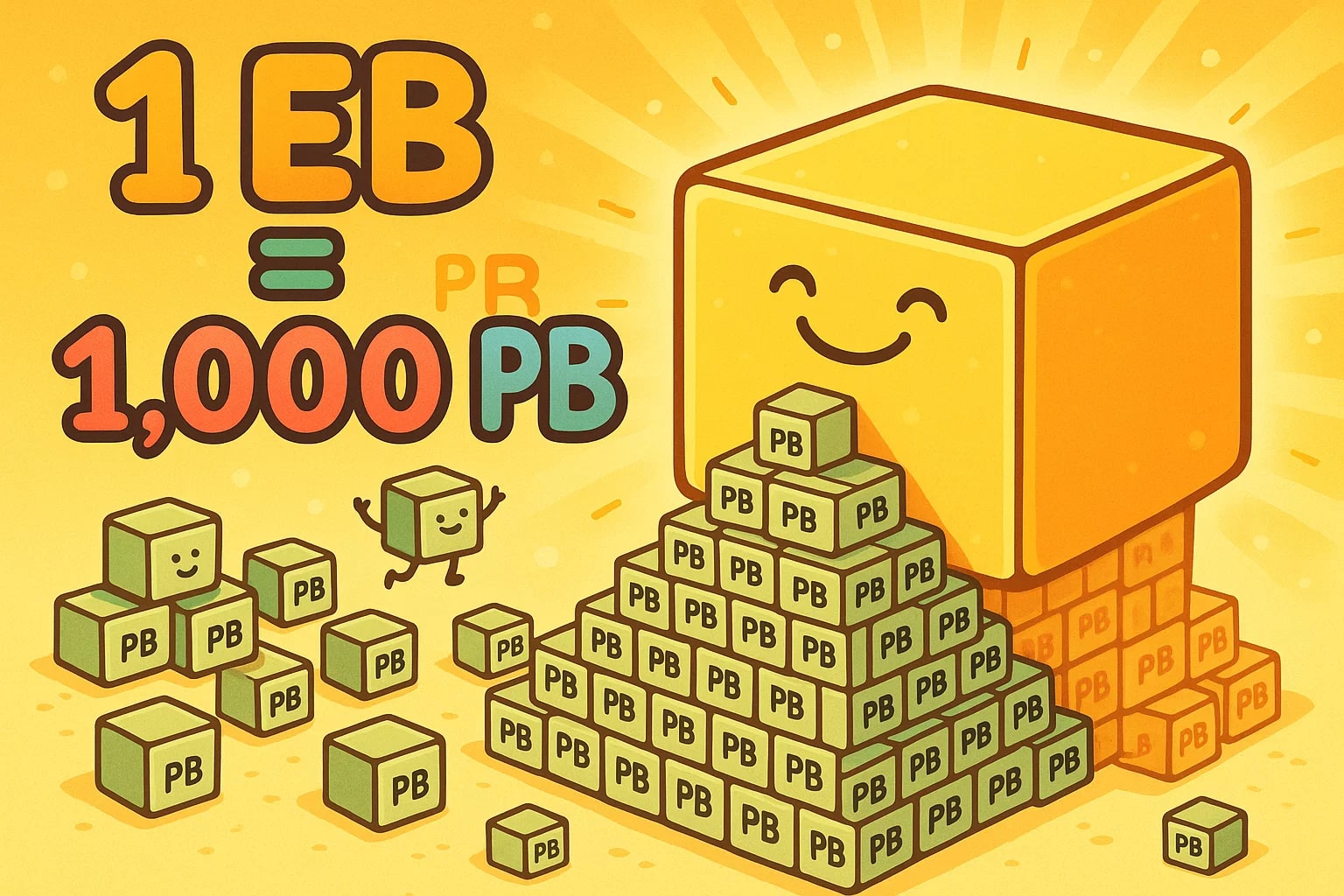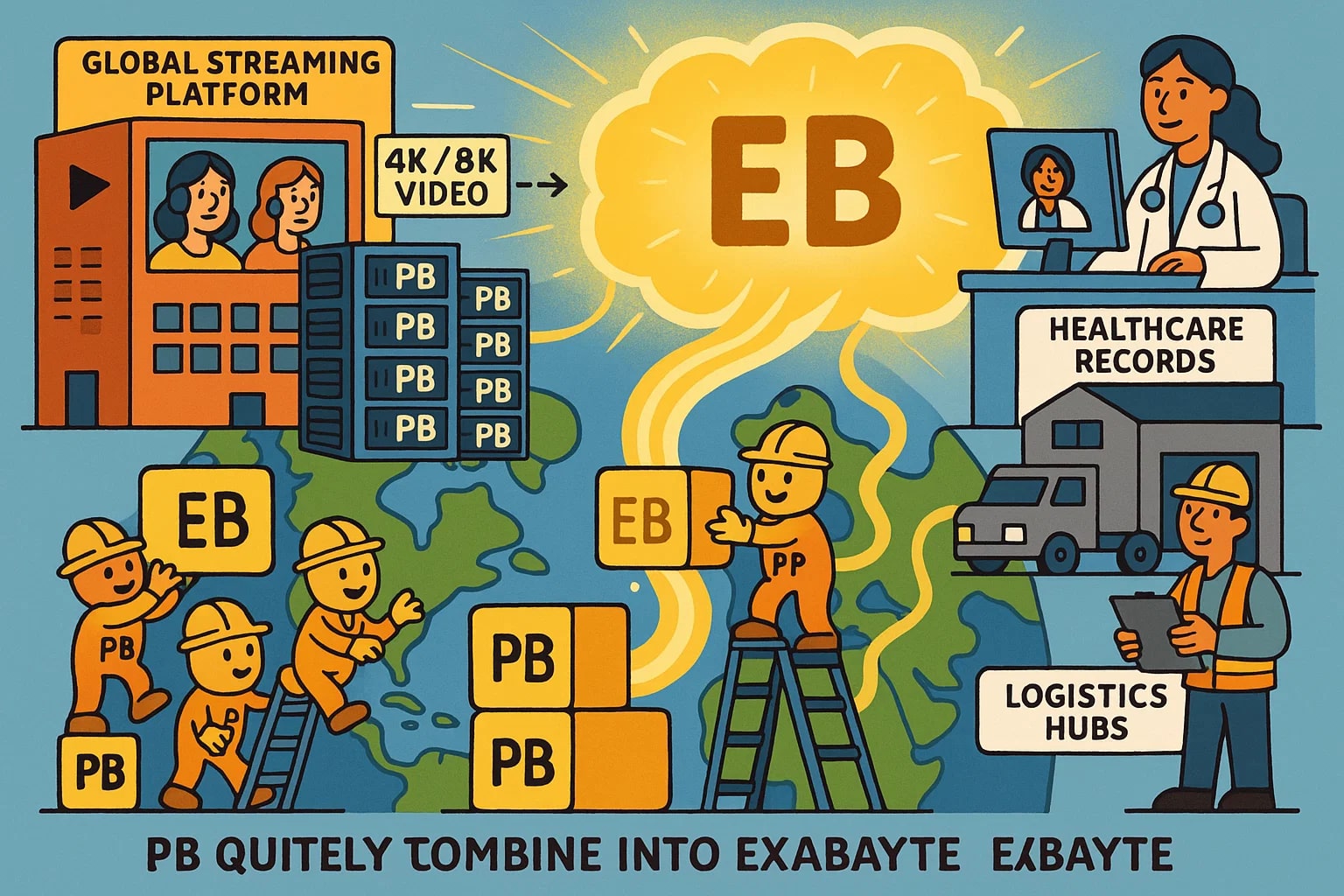petabyte to exabyte – How to convert PB to EB
If you’re working with data at the scale of petabytes, you’re already dealing with huge volumes — think multi-year video archives, full-scale backups, or distributed storage platforms. But what happens when that scale increases tenfold or more? That’s when we move into exabytes, a unit often reserved for the largest data ecosystems on Earth.
This guide walks you through converting petabytes (PB) to exabytes (EB) — with the formula, practical examples, and a look at where these massive units play a role in our digital world.

What is a petabyte (PB)?
A petabyte is equal to 1,000,000 gigabytes or 1,000,000,000,000,000 bytes. It’s commonly used in:
-
Enterprise-level storage
-
Cloud computing systems
-
High-resolution image archives
-
AI model training datasets
-
National digital records
To visualize: storing 1 PB of video in HD quality would take more than 13 years of continuous footage — that’s how much data we’re talking about.
What is an exabyte (EB)?
An exabyte equals 1,000 petabytes, or 1,000,000,000,000,000,000 bytes. This is the unit that describes the data capacity of entire cloud regions, major content delivery networks, and national-level archives.
Exabytes are used in:
-
Internet backbone traffic
-
Cloud infrastructure at hyperscale
-
Global scientific data (e.g., astronomy, genomics)
-
Corporate data lakes spanning decades
It’s no exaggeration to say that exabytes represent the future of storage — and we’re already living in it.
How to convert petabyte to exabyte
This one’s as straightforward as it gets:
1 exabyte = 1,000 petabytes
So:
exabytes = petabytes ÷ 1,000
or
exabytes = petabytes × 0.001
Let’s look at some examples.
A research institute stores 7,500 PB of raw genomic and climate data:
7,500 ÷ 1,000 = 7.5 EB
An international cloud service logs 2,000 PB of user data per month:
2,000 × 0.001 = 2 EB
Your organization plans to archive 450 PB of production data:
450 ÷ 1,000 = 0.45 EB
For quick conversions at any scale, use the Data Storage Converter, or explore more tools in the Conversion tools collection.
Did you know?
-
Global internet traffic exceeded 120 exabytes per month in 2023 — and it’s still accelerating.
-
Meta reportedly manages over 1 exabyte of photo and video storage, replicated across data centers around the world.
-
In astronomy, the Square Kilometre Array (SKA) project is expected to generate 1 exabyte of data per day when fully operational.
-
Major genome sequencing initiatives — like the UK Biobank — work with exabyte-scale storage to hold millions of DNA maps.
-
Cloud vendors like AWS, Google, and Microsoft Azure scale infrastructure by the exabyte to support services across multiple continents.
From petabytes to exabytes – when big becomes global
In 2010, owning a petabyte of storage was a bragging right. Today, many mid-size enterprises hit that mark with backups alone. As AI expands, cloud adoption grows, and sensors collect data from every corner of the planet, we’re pushing further into exabyte-scale operations.
Take media companies, for instance. A global streaming platform that offers 4K and 8K content stores tens of petabytes — and replicates it across regions. Soon, those multiple copies and user histories combine into exabyte-sized datasets.
The same happens in sectors like healthcare and logistics. Data isn’t just collected — it’s analyzed, modeled, shared, and stored for regulatory or operational continuity. That’s how thousands of petabytes quietly turn into exabytes.

Quick math for massive data
Whenever you need to scale up:
exabytes = petabytes ÷ 1,000
This formula bridges two of the largest decimal-based units in computing — ideal for infrastructure planning, usage reports, or long-term digital archives.
Try our Data Storage Converter for instant results. For everything else, Jetcalculator’s complete Conversion tools help you handle digital data in every unit, from the smallest bit to the next big leap.

